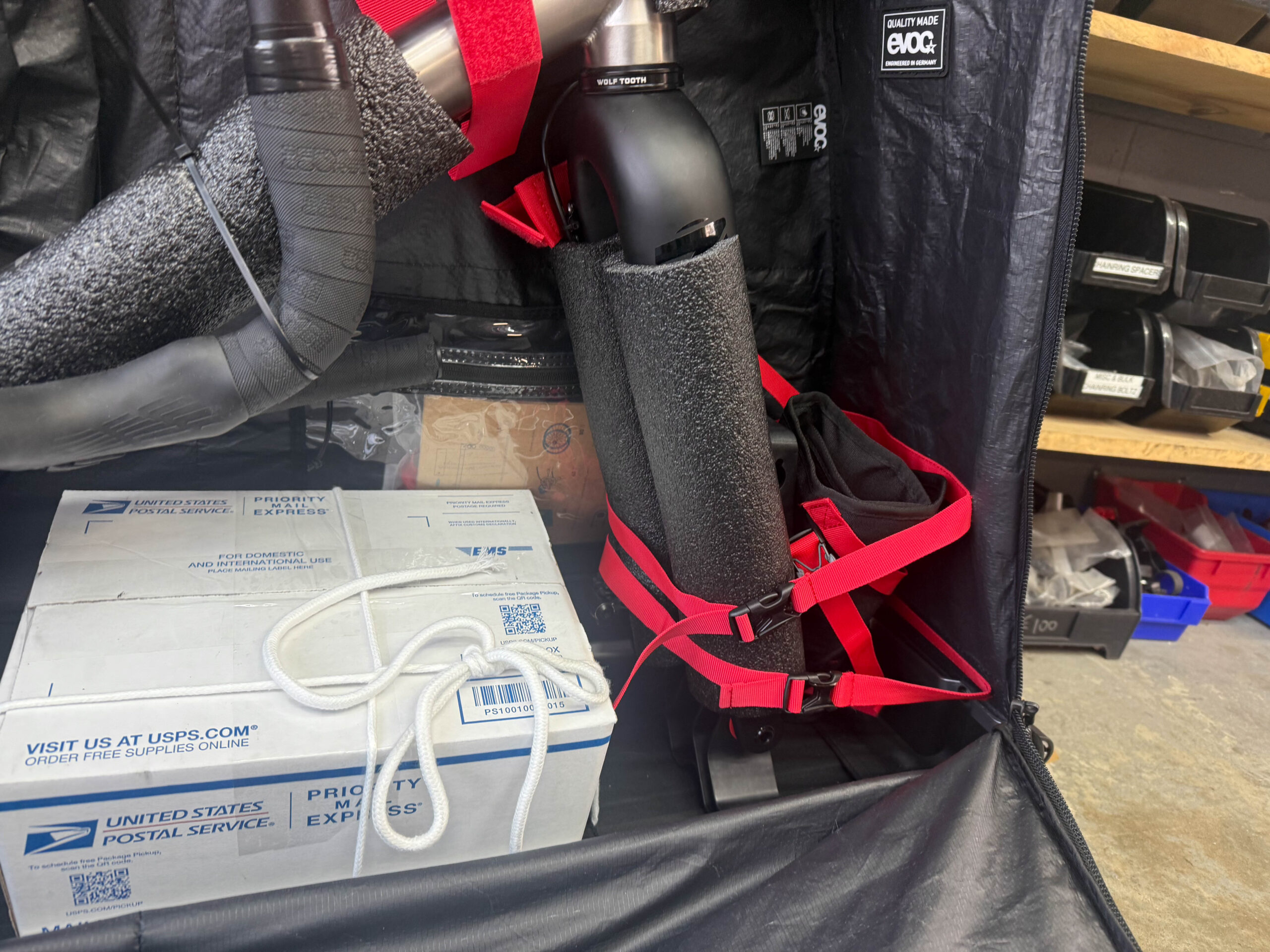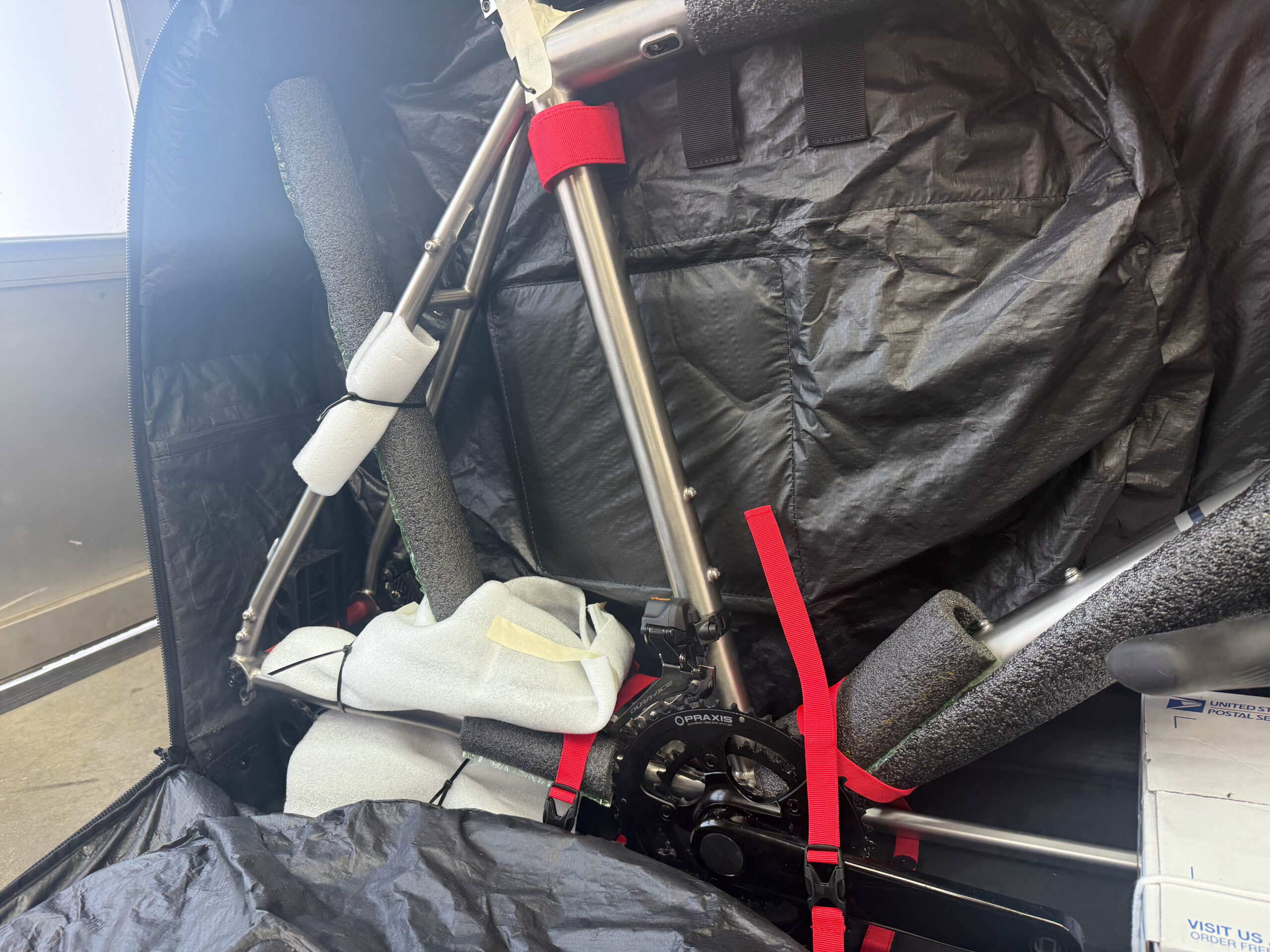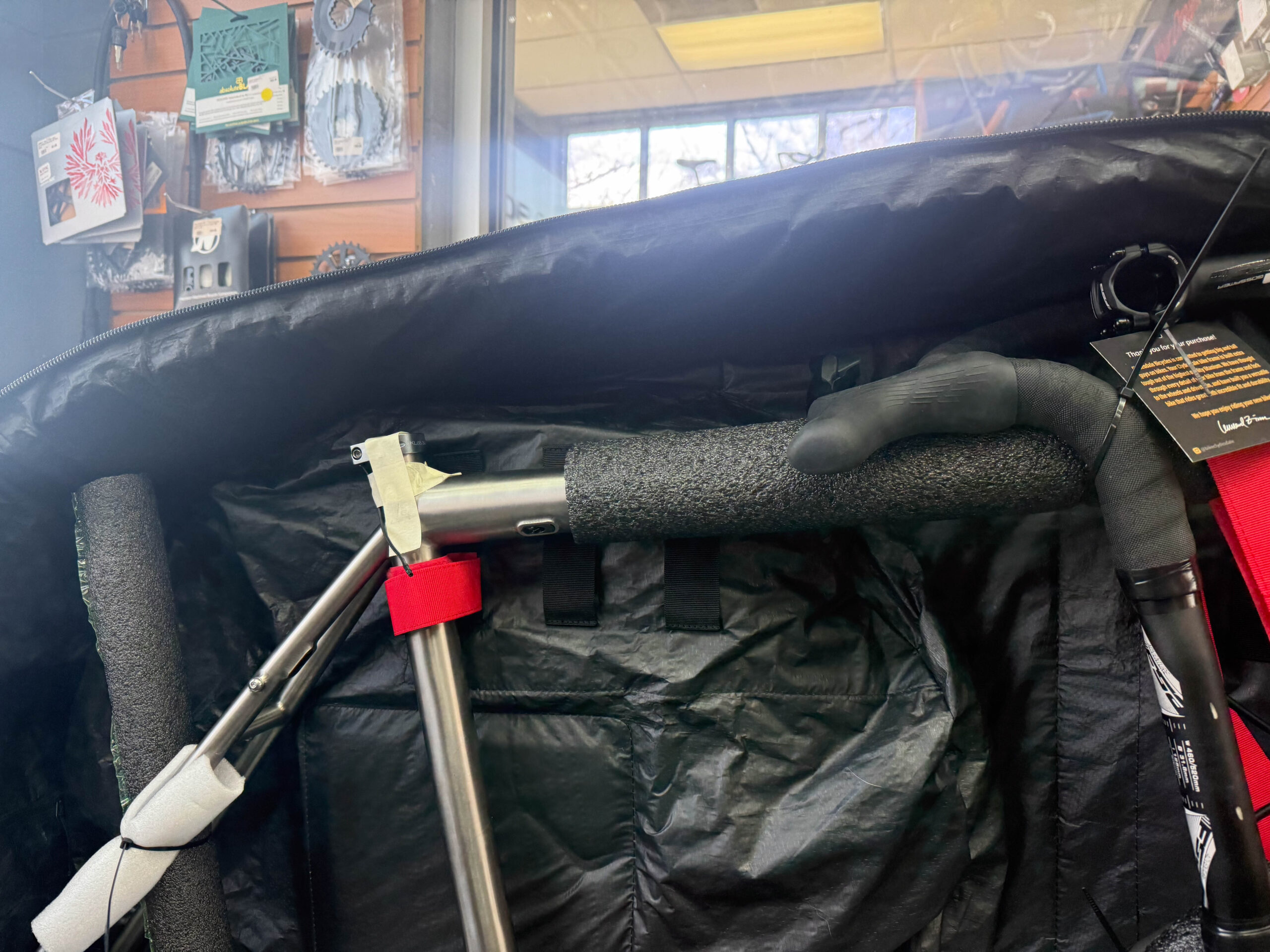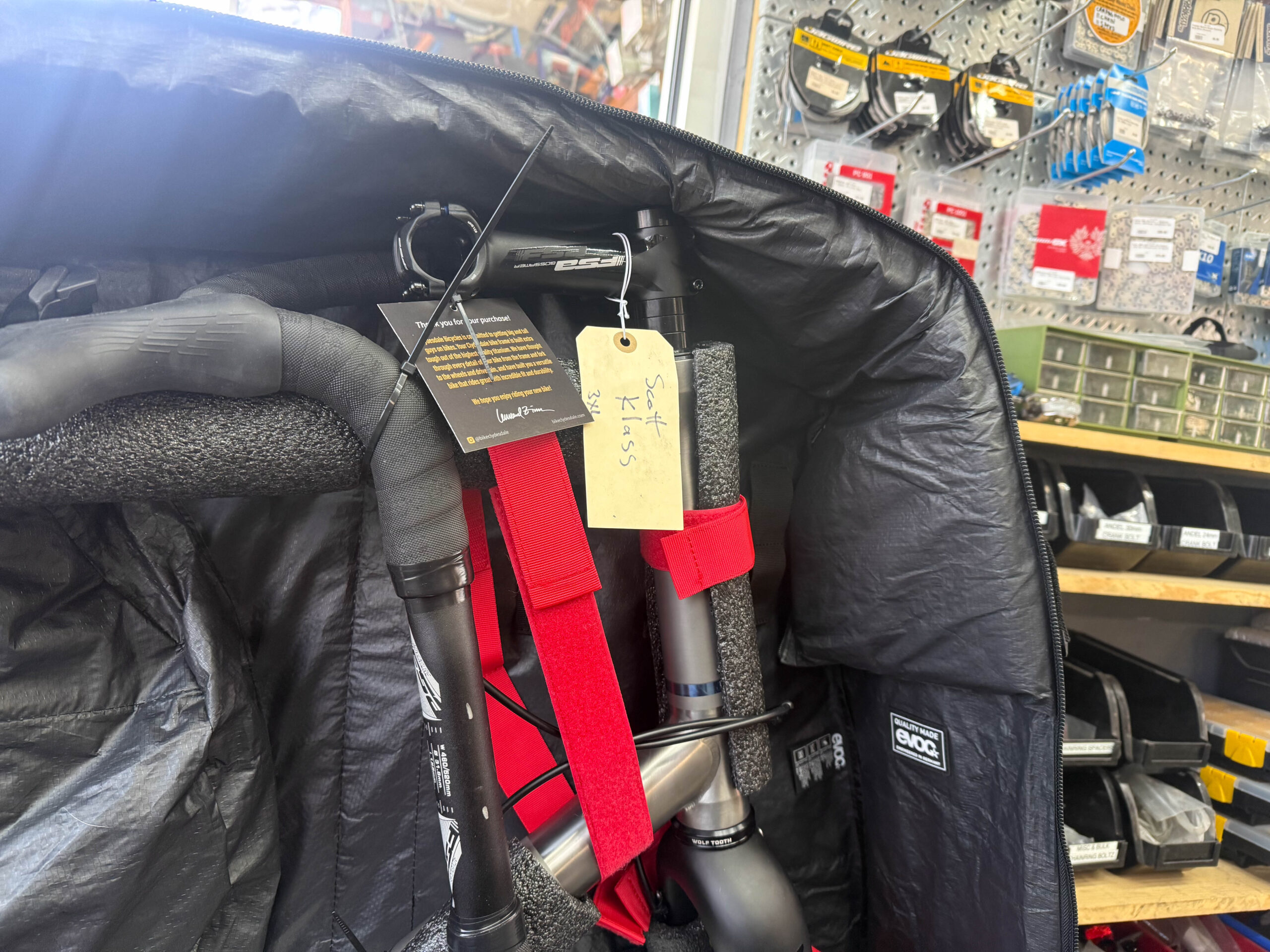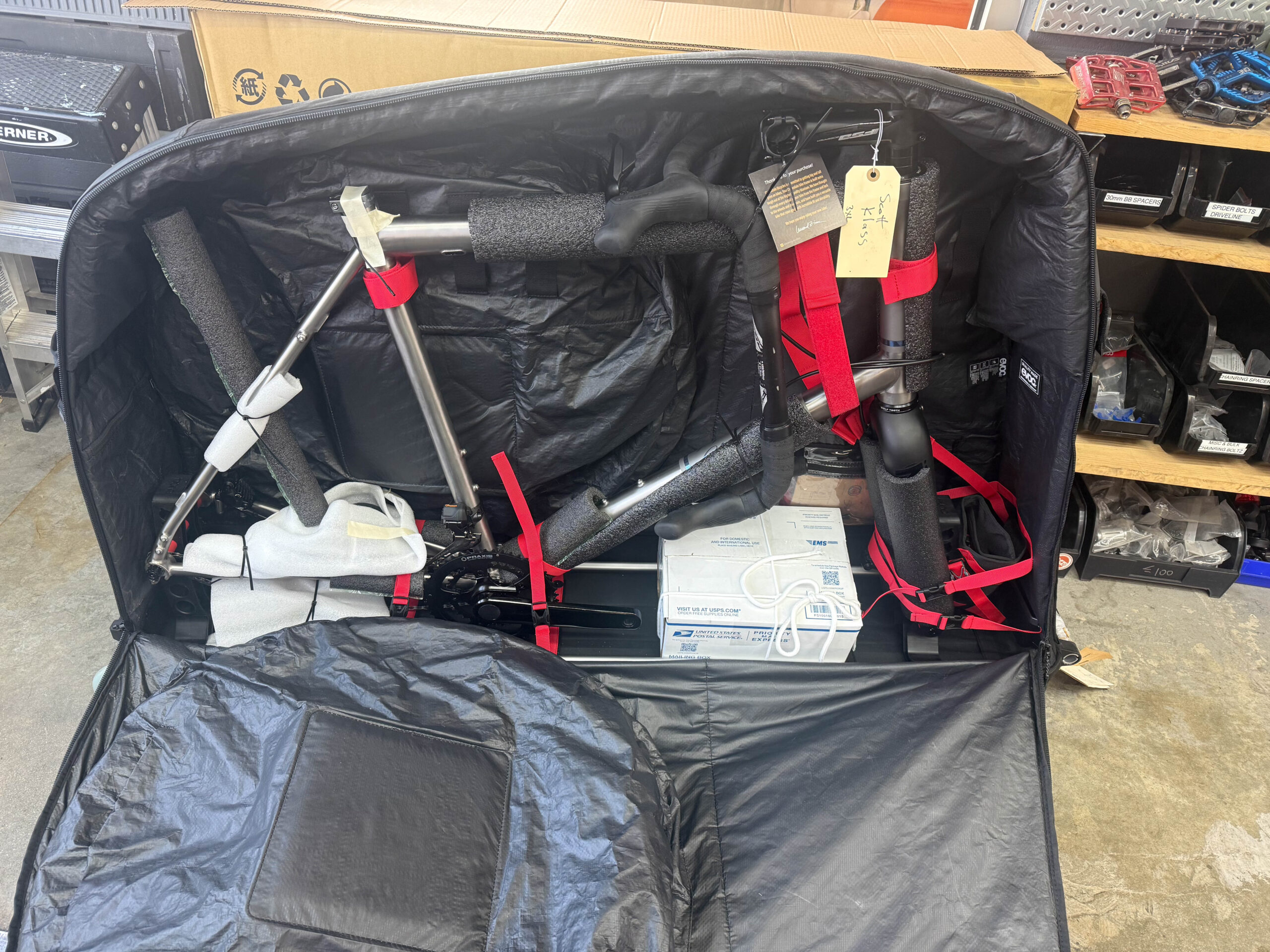Traveling with a big bike
By Lennard Zinn
Traveling with a bike always presents challenges. Traveling with a bike built for a tall person or with a bike that has an extra tall front end for an upright riding position presents even more challenges.
The ideal way to travel with a road or gravel bike is with one of our coupled travel bikes, which break down to fit in an airline-sized travel case to fly without additional oversized luggage charges. This post, Rather, addresses flying with a tall (and long) bike without couplers in either a hard bike case or in a soft-sided bike bag with a hard bottom and wheels. You can also fly with a bike box, and I have written instructions for this blog on how to pack your bike in one. A bike box is fine (perhaps preferable) for one-way travel and is cumbersome for round trips.

The two biggest challenges for fitting a tall bike into a container suitable for flying with are the total length of its fork and its long wheelbase. Some bikes will simply be too long or too tall for any commercially available bike travel bag or case. That said, I have successfully gotten bikes into those travel containers that were much bigger than they were rated for.
I prefer a soft-sided bike bag with a solid bottom and wheels. For tall bikes, this one from EVOC or this one from Sci-Con I have found to be expandable enough to fit a very tall bike (up to 3XL).

Zinn 3XL Full Suspension Mountain Bike in the EVOC case
The EVOC travel bag seems to have plenty of length for tall road/gravel bikes. Its height is more of a limitation, but since it is soft and flexible, I have managed to fit in 3XL Clydesdale Drafts if they have no more than 40mm of total headset spacers. For comparison, the 3XL Draft or Team frame has a 295mm long head tube, and its Zinn Duro fork is 395mm from axle to crown. So, with 20mm of headset stack, 40mm of stem stack, and 40mm of spacers, the steering tube length is 395mm, making it conceivable to fit in this bag a fork with total length from top to bottom of around 800mm.
With the EVOC bag and a tall bike like a 3XL Draft:
- Click the rear dropout support onto the end of the horizontal stays.
- Secure the dropouts onto the lowest set of holes in the support that you can get the bike’s rear end onto.
- Slide the front support back as far as necessary on the horizontal stays to meet the fork ends.
- Using the lowest set of holes in the front support that you can, install the appropriate-size EVOC end caps for your through axle or quick-release skewer into those holes.
- Secure the fork to the front support.
- Remove the handlebar. Pad and strap it to the top tube.
- Loosen the bolts securing the stem around the steering tube and rotate the stem to point backward.
- Zip the bag up first with the front zipper pull, pulling the top of it up as needed to get over the stem.
- Zip the rear zipper pull up to meet the front one.
The primary limitation of the Sci-Con AeroComfort bag for a tall bike is likely its length (due to the angled-back front of the bag), with the secondary one being its height. The fork mount slides back and forth to adjust to shorter and longer wheelbases, and if your wheelbase is too long for the case, you won’t be able to close the zipper around the fork ends. By turning the fork around backward, you may solve the length problem (the handlebar will need to come off). However, turning the fork backward will also lift the front end of the bike higher, and if the bag already was just barely tall enough, this could push it over the top, literally.
I can get both of my tall (slightly bigger than 2XL Clydesdales) e-bikes in a Sci-Con AeroComfort bag. In addition to a long (63.5cm) top tube length (and consequent long front center dimension from bottom bracket to front hub), my first road/gravel e-bike had very long (468mm) chainstays due to the length of the Bosch Gen. 2 motor. My more recent road/gravel e-bike with the stubbier Bosch Gen. 4 motor has much shorter (445mm) chainstays and makes fitting in the Sci-Con bag considerably easier.
I remove the handlebar, strap it to top tube, and turn the fork around backward. With its 263mm-long head tube, the top of the stem is much taller than the Sci-Con bag was designed for, especially with the fork turned around backward. However, there is enough give in the soft bag that I can get it zipped. I have had to replace the zipper once, and I have patched the area in the front adjacent the zipper where my fork was pushing against the top of the bag. With those modifications, it has continued to work fine for years.
The tallest fork/head tube that will probably fit in that Sci-Con AeroComfort bag is either a head tube length of 250mm plus 20mm of total headset spacers with a Zinn Duro gravel fork or a head tube length of 265mm plus 20mm of total headset spacers with an ENVE AR fork.
It may seem that a hard case will protect the bike better, and a hard case like this one from Sci-Con is a good option. With a tall bike or one with an extra long head tube, you may have to remove the fork to get it into the case. That provides considerable extra headaches, not the least of which are finding a spot to fit the fork in the case and re-installing and readjusting the headset and front brake, especially with a disc brake.
If your bike is too big for either of these cases, the best option is the XL Bike Box from ShipBikes.com. This box comes with hardware to mount the fork onto a stable structure to keep the bike stable and in place. The outer cardboard can be replaced when it gets beat up. You should get 2-3 trips out of the box before needing to replace the cardboard shell.

With any soft bag, and even any hard case, I recommend removing the rear derailleur from the dropout, since it is otherwise very vulnerable to damage.
As a frame builder, Lennard Zinn has been designing and building custom bicycles for over 42 years; he founded Zinn Cycles in 1982 and co-founded Clydesdale Bicycles in 2017. His Tech Q&A column on Substack follows his 35-year stint as a technical writer for VeloNews (from 1987 through 2022). He is a former U.S. National Cycling Team member and author of many bicycle books including Zinn and the Art of Mountain Bike Maintenance, Zinn and the Art of Road Bike Maintenance, and The Haywire Heart. He holds a bachelor’s degree in physics from Colorado College.
Follow Lennard Zinn on Substack, Strava, X, Instagram, LinkedIn, or Facebook.



